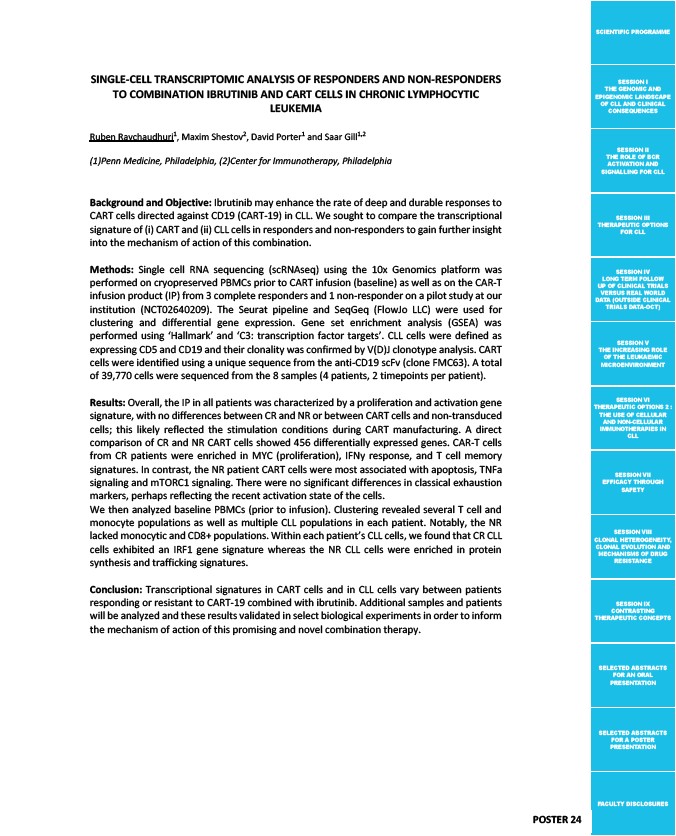
SCIENTIFIC PROGRAMME
SESSION I
THE GENOMIC AND
EPIGENOMIC LANDSCAPE
OF CLL AND CLINICAL
CONSEQUENCES
SESSION II
THE ROLE OF BCR
ACTIVATION AND
SIGNALLING FOR CLL
SESSION III
THERAPEUTIC OPTIONS
FOR CLL
SESSION IV
LONG TERM FOLLOW
UP OF CLINICAL TRIALS
VERSUS REAL WORLD
DATA (OUTSIDE CLINICAL
TRIALS DATA-OCT)
SESSION V
THE INCREASING ROLE
OF THE LEUKAEMIC
MICROENVIRONMENT
SESSION VI
THERAPEUTIC OPTIONS 2 :
THE USE OF CELLULAR
AND NON-CELLULAR
IMMUNOTHERAPIES IN
CLL
SESSION VII
EFFICACY THROUGH
SAFETY
SESSION VIII
CLONAL HETEROGENEITY,
CLONAL EVOLUTION AND
MECHANISMS OF DRUG
RESISTANCE
SESSION IX
CONTRASTING
THERAPEUTIC CONCEPTS
SELECTED ABSTRACTS
FOR AN ORAL
PRESENTATION
SELECTED ABSTRACTS
FOR A POSTER
PRESENTATION
FACULTY DISCLOSURES
SINGLE-CELL TRANSCRIPTOMIC ANALYSIS OF RESPONDERS AND NON-RESPONDERS
TO COMBINATION IBRUTINIB AND CART CELLS IN CHRONIC LYMPHOCYTIC
LEUKEMIA
Ruben Raychaudhuri1, Maxim Shestov2, David Porter1 and Saar Gill1,2
(1)Penn Medicine, Philadelphia, (2)Center for Immunotherapy, Philadelphia
Background and Objective: Ibrutinib may enhance the rate of deep and durable responses to
CART cells directed against CD19 (CART-19) in CLL. We sought to compare the transcriptional
signature of (i) CART and (ii) CLL cells in responders and non-responders to gain further insight
into the mechanism of action of this combination.
Methods: Single cell RNA sequencing (scRNAseq) using the 10x Genomics platform was
performed on cryopreserved PBMCs prior to CART infusion (baseline) as well as on the CAR-T
infusion product (IP) from 3 complete responders and 1 non-responder on a pilot study at our
institution (NCT02640209). The Seurat pipeline and SeqGeq (FlowJo LLC) were used for
clustering and differential gene expression. Gene set enrichment analysis (GSEA) was
performed using ‘Hallmark’ and ‘C3: transcription factor targets’. CLL cells were defined as
expressing CD5 and CD19 and their clonality was confirmed by V(D)J clonotype analysis. CART
cells were identified using a unique sequence from the anti-CD19 scFv (clone FMC63). A total
of 39,770 cells were sequenced from the 8 samples (4 patients, 2 timepoints per patient).
Results: Overall, the IP in all patients was characterized by a proliferation and activation gene
signature, with no differences between CR and NR or between CART cells and non-transduced
cells; this likely reflected the stimulation conditions during CART manufacturing. A direct
comparison of CR and NR CART cells showed 456 differentially expressed genes. CAR-T cells
from CR patients were enriched in MYC (proliferation), IFNy response, and T cell memory
signatures. In contrast, the NR patient CART cells were most associated with apoptosis, TNFa
signaling and mTORC1 signaling. There were no significant differences in classical exhaustion
markers, perhaps reflecting the recent activation state of the cells.
We then analyzed baseline PBMCs (prior to infusion). Clustering revealed several T cell and
monocyte populations as well as multiple CLL populations in each patient. Notably, the NR
lacked monocytic and CD8+ populations. Within each patient’s CLL cells, we found that CR CLL
cells exhibited an IRF1 gene signature whereas the NR CLL cells were enriched in protein
synthesis and trafficking signatures.
Conclusion: Transcriptional signatures in CART cells and in CLL cells vary between patients
responding or resistant to CART-19 combined with ibrutinib. Additional samples and patients
will be analyzed and these results validated in select biological experiments in order to inform
the mechanism of action of this promising and novel combination therapy.
POSTER 24